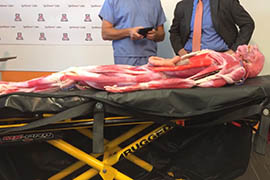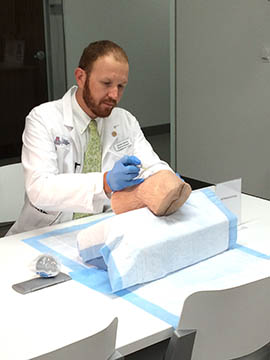Cronkite News has moved to a new home at cronkitenews.azpbs.org. Use this site to search archives from 2011 to May 2015. You can search the new site for current stories.
Practice makes perfect: UA medical school adding synthetic cadavers
PHOENIX – As second-year medical student James Gentry practices using a needle to remove fluid from a knee, his initial attempt misses and hits bone.
This ordinarily is an extremely painful mistake, but there’s no harm in this case because Gentry is practicing on a synthetic knee.
A collaboration announced Wednesday between SynDaver Labs and the University of Arizona College of Medicine-Phoenix will have medical students practicing on synthetic cadavers, which in addition to being eerily lifelike replace real cadavers or practicing on animals.
Gentry said he’s grateful to have the chance to practice over and over on the procedure he demonstrated. In this case, the synthetic cadaver was a knee joint from which he eventually drew saline solution.
“When you go into a patient’s room, you can say to yourself that you’ve done this a lot and you’re confident about it,” he said.
The cadavers, which include a knee joint, partial torso and arm as well as complete bodies with or without skin, are touted as simulating living human tissue more realistically than real cadavers. Like people, they are mostly water.
Christopher Sakezles, president of Tampa, Fla.-based SynDaver Labs, said the technology changes the way that medical students are trained.
“At the end of the day, this is all about medical education and reducing the cost of health care in general,” he said.
SynDaver is stationing 10 employees at the medical school and considering moving its headquarters to Phoenix, Sakezles said, adding that UA will provide feedback that will help SynDaver make improvements.
Dr. Stuart Flynn, dean of the University of Arizona College of Medicine-Phoenix, said that one of the university’s chief goals is preparing students for changes in medical technology.
“We believe that this collaboration will allow significant advancement in health care through research,” he said. “We expect to improve patient safety and provide better outcomes.”
Dr. Teresa Wu, director of simulation education for the University of Arizona College of Medicine-Phoenix, said that one of the biggest challenges for medical students is overcoming nervousness about treating patients.
“We are used to practicing on patients the first time we learn how to do techniques,” she said. “And with the SynDaver models we can actually do procedures, practice ultrasound and do manipulations on a model that feels like a live human being without putting human beings at risk.”
Rheana Techapinyawat said she and other second-year medical students will worry less about making mistakes because they aren’t practicing on live patients.
“When you go in without any experience at all, it gets to be painful for the patient – all the poking and prodding – and sometimes causes harm,” she said.










